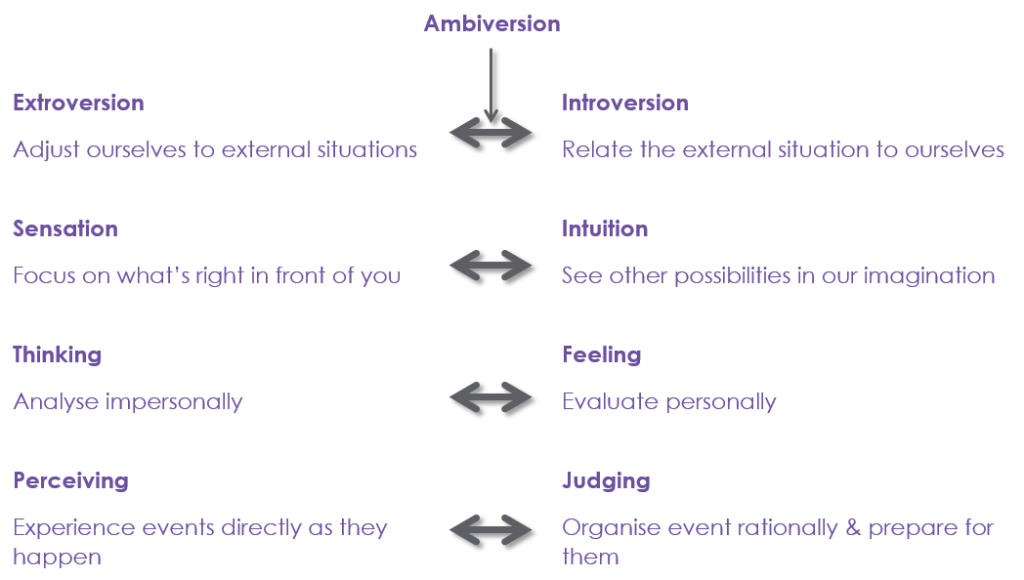Understanding what people do, as well as how and why they behave a certain way, is at the heart of what Bunnyfoot does. Part of this is understanding different personality types and the different stimulus that suit these.
“The meeting of two personalities is like the contact of two chemical substances. If there is any reaction, both are transformed.” – Carl Jung
Introversion and extroversion
Each of us sees reality according to our own personality type. All personality types have strengths and weaknesses, each has something to bring to the table and room for improvement. Understanding your personality type and others helps us understand why we negotiate reality the way we do and ultimately work together more effectively.
Where you fall on the introvert-extrovert continuum is one of the most important aspects of personality. This is basically a measure of the level of outside stimulation you need in order to function well. This will influence your choice of friends, careers, how you make conversation, resolve differences, show emotion (just for starters). Many people will have personality elements of both introversion and extroversion, depending where you are on the scale. If you are right in the middle of this continuum you are an ambivert.
We seek stimulus that allows us to use our skills best. Personality differences are largely a matter of functional preferences, distinct ways of knowing and interacting with the world. The diagram below shows the different psychosocial functions that are part of everyone’s personality. Your preferred functions are not set in stone, they can change at different life stages.

Many psychologists agree that introverts and extroverts work differently. The table below shows the general differences:
| Extroverts | Introverts |
|---|---|
| Action: tackle assignments more quickly, fast decision makers | Contemplation: work more slowly & deliberately |
| Risk-taking | Heed-taking |
| Like to multitask | Prefers to focus on one task at a time |
| Talkers | Listeners |
| Think out loud | Think before they speak |
| Prefers team work | Prefers individual work |
| Needs to socialise | Prefers their own company |
| Prefers environments with a lot of stimulation | Prefers environments that aren’t over-stimulating |
How technology can help us all
In western societies we live in an extrovert ideal value system, where extroversion traits are considered preferable. But Cain (2012) says forcing everyone to act like extroverts harms the quality our work and our lives. There are many digital tools that are helping to mitigate this harm.
Studies have shown that face-to-face brainstorming and teamwork often lead to inferior decision making, as social dynamics leads groups astray, merging around the loudest most confidently asserted idea. Hence why we at at Bunnyfoot rarely recommend focus groups and instead lean toward one-on-one research techniques.
Technology such as virtual collaboration tools can be used to allow the way introverts and extroverts work together and complement each other, with team members thinking about solutions alone, before getting together to talk them over. Researchers have found that working in this way, groups generate better ideas and solve problems more proficiently (Cain, 2012). Thus, to get the best out of the majority of a group they need to work alone first and then network later, which could be done online, or face-to-face.
Why it works
Being able to spontaneously come up with ideas and thinking by talking isn’t necessarily about extroverts having more mental agility / intelligence, but it is about preference for stimulation. Introverts tend to be reflective deep-thinkers that like to have a chance to prepare first. Public speaking is inherently a ‘stimulating’ activity, those who feel over stimulated by public speaking / networking will find their attention and short term memory impaired. But preparation can help greatly for public speaking and networking. Working together will allow extroverts to refine (their) initial ideas and generate new ideas from those presented after solo work. It gives space for introverts and extroverts to think in the way they prefer.
This kind of working practice works for both introverts and extroverts as:
- Extroverts strive to affect their circumstances in a way that is visible to others and are in turn affected by others’ opinions and expectations.
- Introverts strive to consolidate their territory. They don’t share their inner worlds straight away and may resist the influence of others.
For Bunnyfoot consultants, taking this knowledge into account is useful during moderation in usability testing sessions, for example, it can help us understand what is happening, as part of our observation of participants. Being mindful of the way people act and think (and the potential reasons / causes) is something we can all benefit from.
Want to learn more?
- Training Course: Fundamentals of Design thinking and Ideation
- Training Course: Designing for the Human Mind/Brain
References / Sources
- Susan Cain. 2012. Quiet: The power of introverts in a world that can’t stop talking.
- Lenore Thomson. 1998. Personality Type: An Owner’s Manual. Shambhala.
- Elizabeth Hirsh, K.W., Hirsh, S.K., Hirsh. 2003. Introduction to type and teams. 2nd Ed. CPP, Inc.
- Berens, L.V., Cooper, S.A., Ernst, L.K., Martin, C.R>, Myers, S., Nardi, D., Pearman, R.R., Segal, M., Smith, M.A.. 2001. Quick Guide to the 16 Personality Types in Organisations. Telos.
- Karten, N. 2008., Introverts & extroverts in the workplace
- Vanessa Barford, Are we giving introverts a hard time?




